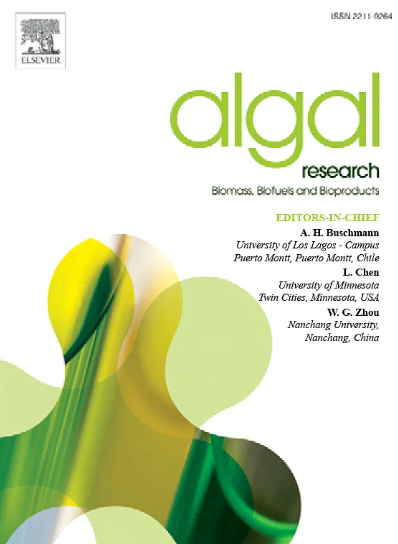Synergistic impact of elevated CO2 and photo-bioreactor illumination surface area on marine microalgal biomass and bio-chemicals production
IF 4.6
2区 生物学
Q1 BIOTECHNOLOGY & APPLIED MICROBIOLOGY
Algal Research-Biomass Biofuels and Bioproducts
Pub Date : 2025-06-17
DOI:10.1016/j.algal.2025.104156
引用次数: 0
Abstract
This study investigates the synergistic effects of enriched CO2 and illumination surface area of a photo-bioreactor (PBR) on the growth, biochemicals and pigment production of marine microalgae. Accordingly, marine Chlorella sp. and D. salina were cultivated under various conditions, including ambient CO₂ (AC: 0.04 %, v/v) and high CO₂ (HC: 15 %, v/v), with two illumination surface area-to-volume (IS/V) ratios: low (0.22 cm−1) and high (0.44 cm−1). The results demonstrated that both marine strains showed significant changes in biochemical yields under different cultivation conditions, with the highest biomass yield of 2.01–2.07 g L−1 observed when HC and high IS/V ratio were combined. These biomass yields are 107–132 % higher compared to AC and low IS/V conditions. Chlorella sp. and D. salina cultured under the combined HC with high IS/V conditions significantly improved the production of lutein and lipid by 163–417 % and 12–36 %, respectively. However, the maximum protein (178–188 mg g−1) and carbohydrate (182–284 mg g−1) yields in both strains were achieved under AC with high IS/V and low IS/V conditions, respectively. CO2 sequestration of 0.40–0.51 g L−1 d−1 exhibited by these strains are comparatively higher than most of the marine microalgae reported in the literature. The novelty of this study lies in the demonstration of the synergistic effects of elevated CO2 levels (15 %, v/v), equivalent to coal-fired flue gas, and PBR's illumination surface area on marine microalgal cultivation in a seawater-supplemented medium, leading to optimized CO2 fixation, biomass yield, and bio-chemicals production.

CO2升高和光生物反应器光照面积对海洋微藻生物量和生化生产的协同影响
本研究探讨了富CO2和光生物反应器(PBR)光照面积对海洋微藻生长、生化和色素生成的协同效应。因此,在不同的环境CO₂(AC: 0.04%, v/v)和高CO₂(HC: 15%, v/v)条件下,以低(0.22 cm−1)和高(0.44 cm−1)两种光照表面积体积比(IS/ v)培养海洋小球藻和盐藻。结果表明,在不同的培养条件下,这两种海洋菌株的生化产量变化显著,HC和高IS/V比组合时,生物量产量最高,为2.01-2.07 g L−1。与交流和低IS/V条件相比,这些生物质产量高出107 - 132%。在高IS/V组合条件下培养的小球藻和盐藻的叶黄素和脂质产量分别提高了163 - 417%和12 - 36%。在高IS/V和低IS/V条件下,两种菌株的蛋白质和碳水化合物产量分别达到最高(178 ~ 188 mg g - 1)和最高(182 ~ 284 mg g - 1)。这些菌株的CO2固存量为0.40-0.51 g L−1 d−1,比文献中报道的大多数海洋微藻要高。本研究的新颖之处在于证明了二氧化碳浓度升高(15%,v/v)(相当于燃煤烟道气)和PBR的光照表面积对海水补充培养基中海洋微藻培养的协同效应,从而优化了二氧化碳固定、生物质产量和生化生产。
本文章由计算机程序翻译,如有差异,请以英文原文为准。
求助全文
约1分钟内获得全文
求助全文
来源期刊

Algal Research-Biomass Biofuels and Bioproducts
BIOTECHNOLOGY & APPLIED MICROBIOLOGY-
CiteScore
9.40
自引率
7.80%
发文量
332
期刊介绍:
Algal Research is an international phycology journal covering all areas of emerging technologies in algae biology, biomass production, cultivation, harvesting, extraction, bioproducts, biorefinery, engineering, and econometrics. Algae is defined to include cyanobacteria, microalgae, and protists and symbionts of interest in biotechnology. The journal publishes original research and reviews for the following scope: algal biology, including but not exclusive to: phylogeny, biodiversity, molecular traits, metabolic regulation, and genetic engineering, algal cultivation, e.g. phototrophic systems, heterotrophic systems, and mixotrophic systems, algal harvesting and extraction systems, biotechnology to convert algal biomass and components into biofuels and bioproducts, e.g., nutraceuticals, pharmaceuticals, animal feed, plastics, etc. algal products and their economic assessment
 求助内容:
求助内容: 应助结果提醒方式:
应助结果提醒方式:


